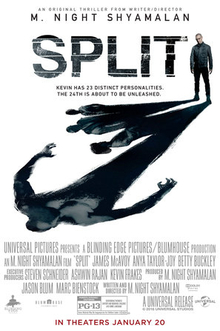| Split | |
|---|---|
 |
by Peter J. O’Connell
Split. Released:
Jan. 2017. Runtime: 117 mins. MPAA Rating: PG-13 for disturbing thematic
content and behavior, violence and some language.
The abduction and imprisonment of a young woman (or women)
by a disturbed individual has been a plot situation of horror and thriller
films off and on since The Collector
in 1965. Recent examples include Room
(2015) and 10 Cloverfield Lane
(2016). Now writer/director M. Night Shyamalan has given us Split, a film about young women abducted
and imprisoned by 23 individuals—well, not exactly “individuals,” let’s say
“personalities” or “alters.”
You see, teenagers Casey (Anya Taylor-Joy), Marcia (Jessica
Sula) and Claire (Haley Lu Richardson) have been seized and held in a
labyrinthine underground complex by “Dennis,” one of 23 personalities
inhabiting the body of Kevin Wendell Crumb (James McAvoy), a victim of
childhood abuse with severe dissociative identity disorder (a/k/a “split
personality” or “multiple personality disorder”).
Psychiatrist Dr. Karen Fletcher (Broadway veteran Betty
Buckley), over the years that she has been treating Kevin, has found him to be
generally stable, with the personalities controlled by one of them known as
“Barry,” a sketch artist with a Boston accent. And Kevin has cooperated with
Dr. Fletcher as she researches her belief that psychological imbalance can
cause physiological changes.
But now it seems that Dennis, who has obsessive/compulsive
disorder and violent tendencies, is beginning to supplant Barry as Kevin’s
dominating alter. There is also “Patricia,” who dresses as a woman and speaks
with a British accent. Patricia hints to the three girls that they will serve a
“greater purpose.”
And “Hedwig,” who has a female name but claims to be a nine-year-old
boy, confides to them that they may be sacrificed to “The Beast,” a possibly
emerging 24th personality of great strength and ferocity. Hedwig also performs
a manic dance, the most hilarious/creepy terpsichorean endeavor since that done
by Ralph Fiennes’ character in A Bigger
Splash (2015).
As suspense intensifies, the three girls, particularly
Casey, a victim of child abuse herself, make various attempts at escape before
The Beast is unleashed. Anya Taylor-Joy, so good in The Witch (2015), is also good here, but everything in the film
pales in comparison to the astonishing performance of James McAvoy. His
absolute mastery of gesture, movement and voice empowers him to create the
various personalities convincingly—and instantly, shift between them seamlessly,
have them converse with each other, and, at times, even have them pretend to be
one another.
Shyamalan, auteur of The
Sixth Sense (1999), Unbreakable (2000)
and The Visit (2015), is known as the
master of the “twist” ending. Let’s just say that, gripping as Split is, the twist at its end is not as
tightly tied as in those previous films.
No comments:
Post a Comment